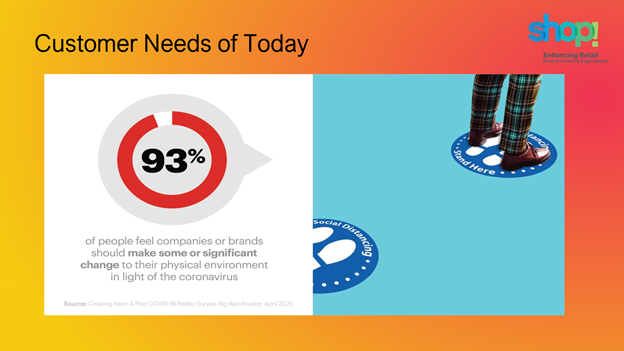The Effects of COVID-19 on Retail Environments
 Shop! member Big Red Rooster found 93% of consumers expect changes in retail environments in an April 2020 survey
Shop! member Big Red Rooster found 93% of consumers expect changes in retail environments in an April 2020 survey
After months of being relegated to online shopping, home delivery, and curbside pickup, buyers are craving the in-store shopping experience. Under pressure to provide a safe environment, today’s retailers are turning to AV technology, especially digital, to grab consumers’ attention.
“Safety is the cost of doing business now. Retailers are working hard to reimagine a more hygienic and less touch-oriented in-store experience,” said Todd Dittman, Executive Director of Shop!, a global association dedicated to enhancing retail environments and the customer experience. “Technology is stepping up to play a bigger role in the retail experience at a faster pace.”
In the webinar Enhancing the Post-COVID-19 Retail Environments with AV Technology, Dittman discusses the effects of the COVID-19 pandemic on retail sales environments.
“Customers want to be safe, but they also want to get out and shop,” said Dittman. To survive in the post-COVID-19 world, retailers will have to reimagine in-store experiences by implementing more hygienic and effective solutions.
According to AVIXA®’s Industry Outlook and Trends Analysis, retailer spending on pro AV products and services is expected to be down by 14% in 2020 after a peak of $22.7 billion in 2019. As shoppers return to more pre-COVID activity, growth in spending on technology will bounce back in 2021, expanding nearly 6% on an annualized basis to reach $26.3 billion by 2025, the report predicts.
AVIXA estimates show $5.9 billion in displays will be purchased globally by retailers this year, making digital signage and displays one of the flagship opportunities for AV professionals in retail. Despite the declines in retail spending in 2020, the market remains the single largest purchaser of displays.
To help define in-store protocol and direct traffic flow, retailers are using signage, store fixtures, displays, and digital to enhance communication.
Related: Business of AV Roundtable: Reopening Retail
Physical stores are limiting the number of people allowed inside. Customers waiting outside are focused on the store front as they wait to enter, creating opportunities for signage and messaging such as:
- Eye-catching digital signs and graphics in small store windows,
- Digital communication to promote multiple messages, and
- Digital as an attractive part of the store’s overall design to make shoppers feel like they are in a different place.
Low touch has become a focus of the consumer. Technology can be used to help shoppers focus on their other senses. For example, music to set the mood, voice-activated product support, digital-enhanced signage displays, and even devices that can distribute scents.
Helping shoppers locate the right product for their needs is the primary factor in overall shopper satisfaction with the in-store experience. “Because of the way shoppers are now shopping, it is important for retailers to catch their attention in as clear and fast a fashion as possible,” said Dittman.
From the retailer’s perspective, the common rules of signage are that the messaging must be:
- Understood in less than 3 seconds,
- Easily read from at least four paces, and
- Quick and clear, less than five words, and easily read.
According to Dittman, a customer will engage with a product or service at least 20 times while in a store. These touchpoints create opportunities for retailers to incorporate signage or digital to influence the customer.
Other examples of how technology is helping to address the need for low touch include:
- Store apps to provide product information,
- Augmented reality that allows shoppers to interact with a screen (e.g., trying on makeup, which alleviates the need to touch the face), and
- Personal assistance through video
Digital product messages, such as showing someone modeling clothing, “These are prime examples of how technology is becoming a bigger part of the retail experience and helping to promote the store’s ‘wow’ factor and draw attention to the store,” said Dittman.
Read Next: Touchless Technologies Will Define the Next Brand Experiences
Brands are considering the use of experiential technologies that until recently seemed like a reach, but maybe now is their moment to create real connection.






